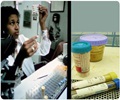Using a toothbrush cover does not protect a toothbrush from bacterial growth, but actually creates an environment where bacteria are better suited to grow.

"The main concern is not with the presence of your own fecal matter on your toothbrush, but rather when a toothbrush is contaminated with fecal matter from someone else, which contains bacteria, viruses or parasites that are not part of your normal flora," said Lauren Aber from Quinnipiac University in the US.
For the study, all toothbrushes were collected from participants using communal bathrooms, with an average of 9.4 occupants per bathroom in Quinnipiac University.
At least 60% of the toothbrushes were found to be contaminated with fecal coliforms.
"Using a toothbrush cover does not protect a toothbrush from bacterial growth, but actually creates an environment where bacteria are better suited to grow by keeping the bristles moist and not allowing the head of the toothbrush to dry out between uses," Aber said.
"Better hygiene practices are recommended for students, who share bathrooms both in the storage of their toothbrush but also in personal hygiene," Aber added.
Advertisement
There are several potential sources of contamination of one’s toothbrush -- toothbrushes stored open in the bathroom are especially vulnerable to contamination with material from the toilet or contamination from other occupants.
Advertisement
Source-IANS













